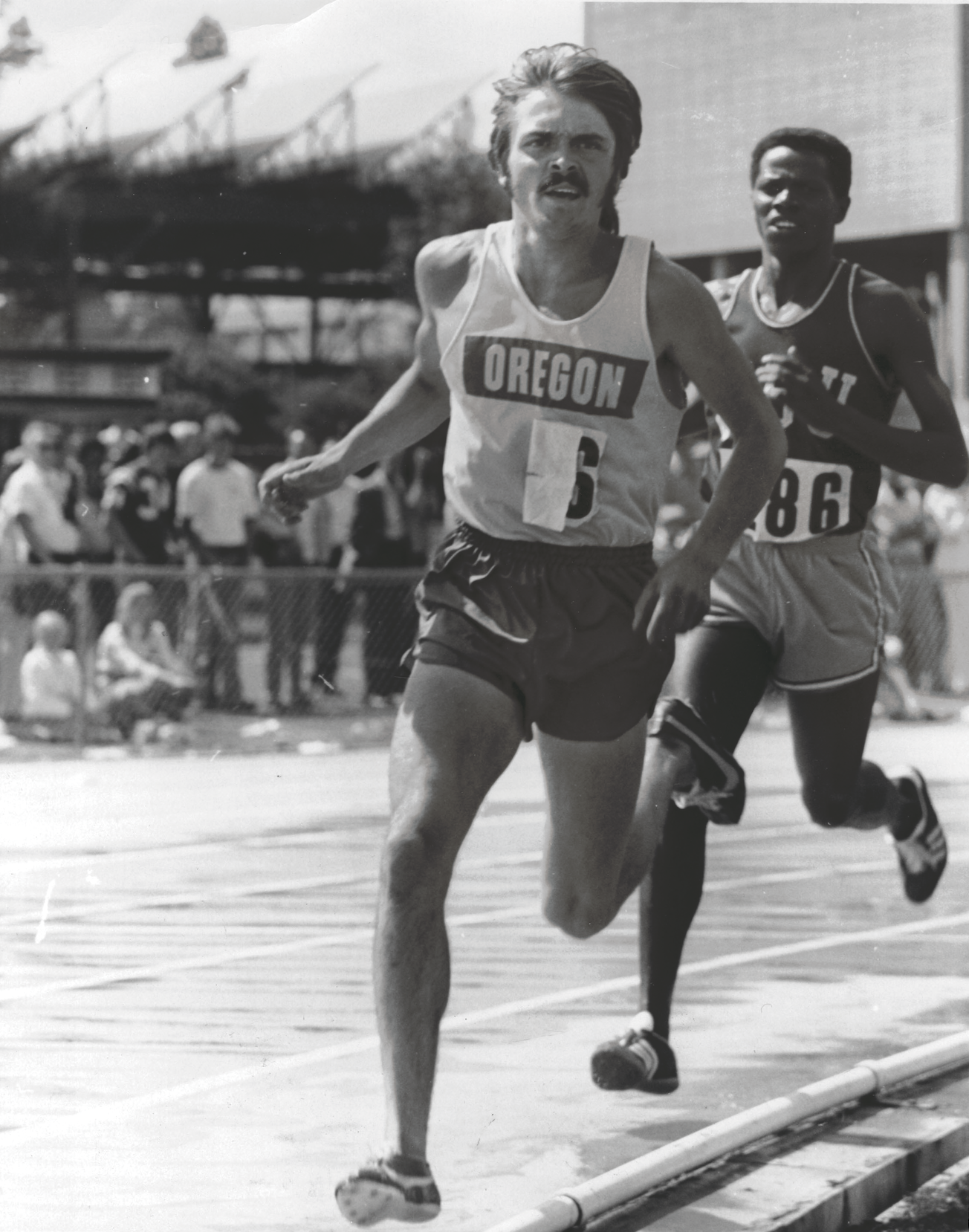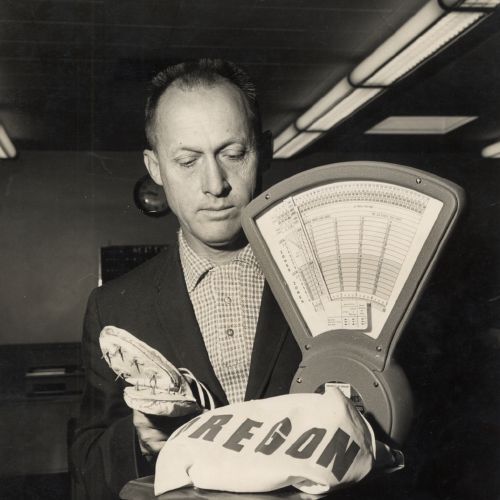Hosting the World Athletics Championships in 2022 was a first for Eugene, but it was not the first time the track world has convened here. Our history as a track hub actually goes back more than 100 years. In 1906, Dan Kelly ran for the Multnomah Athletic Club of Portland while attending the University of Oregon. At one meet he broke world records in the 100- and 220-yard dashes, and placed first in the broad jump. At the 1908 Olympics in London, he won silver in the broad jump. His coach at the time was Bill Hayward, namesake of the University of Oregon’s historic Hayward Field. According to the UO’s sports history archive, at least one UO athlete has participated in the summer Olympics each year it’s been held since 1908. In 1960, the UO had more athletes on the U.S. Olympic team than any other intercollegiate institution.

Then came the 1970s. Bill Bowerman brought out the best in his runners while coaching here, and he also developed the lightweight waffle sole that turned into the company we all know as Nike. This legendary coach brought the Olympic Team Trials to Eugene in 1972, 1976, and 1980 — Eugene is still the only site to host three consecutive trials. Steve “Pre” Prefontaine enrolled at the UO to train under Bowerman. Pre competed in the 1972 Olympic trials, which got him a spot at the 1972 Olympics in Munich. At the time of his untimely death at age 24 in May 1975, while he was training for the 1976 Olympics in Montreal, Pre held every American outdoor track record between 2,000 and 10,000 meters.
University of Oregon head coach and associate athletic director Vin Lananna helped bring the Olympic trials back to Hayward Field in 2008. We also hosted the trials in 2012 and 2016.
Steve “Pre” Prefontaine
Sports Illustrated featured Prefontaine on its cover in 1970, and he helped fuel running’s surge in popularity at the time. Pre’s memory lives on here through the Prefontaine Classic, held at Hayward Field, which invites only eligible athletes who are ranked in the Top 50 in the world. Athletes and track fans from all over visit Pre’s Rock, which marks the spot with an engraved stone where the runner perished in a car accident. The visitors left flowers, notes, T-shirts, running shoes, and other mementos honoring him. In April, the city of Eugene enhanced safety at the site by adding a new railing to protect visitors from road traffic and an expanded sidewalk and viewing area.
Hayward Field
Back in 1895, UO students first started running laps on a crude track at 13th and Kincaid (now the Lillis Business Complex). Bill Hayward coached the Webfoots from 1904 to 1947 (we didn’t officially become Ducks until 1978), ultimately coaching four world record holders and nine Olympians. He was on the Olympic Track & Field coaching staff in 1908, 1912, 1920, 1924, 1928, and 1932. He was so well-respected that when the new stadium was constructed at 15th Avenue and Agate Street, it was named after him.
The original site of Hayward Field was marshland — there is a reason we are called the Ducks, after all. Before it was transformed into a football field in 1919 it had been a cow pasture where the university kept cattle to supply milk to the dormitory students. The field served both football and track and field for half a century. According to the UO’s Hayward Field website, Bill Hayward didn’t know that Hayward Field had been named for him until the day after the dedication, which was held during halftime of the first football game, because he had been in the locker room with the team. In 1967, football relocated to Autzen Stadium, leaving the field’s focus on track and field.
The venue became much loved over the course of its history, but eventually it fell into disrepair. In 2018, Hayward Field underwent a significant remodel, completed in spring 2020. The remodel expanded seating from 12,650 to almost 25,000. A new addition as of this year is the Visual Experience Board, which houses more than 5,000 square feet of video screen, making it the largest permanent video screen for a track and field stadium in the country. Coach Hayward is honored here as well, in a metal image that greets fans arriving from Powell Plaza, blending past and present. (Powell Plaza marks the northeast entrance and is named for Lloyd Powell, a beloved UO football and track athlete.)

Nike and the Waffle Sole
Bill Bowerman was a protégé of Bill Hayward. Bowerman, born in Portland, came to the University of Oregon in 1929 to play football and study journalism. It was Hayward who suggested he join the track team. He took over the track program in 1949 and ran it until 1973. Assistant coach Bill Dellinger took over the program after Bowerman’s retirement in 1972. Bowerman led his teams to four NCAA Championships and coached the likes of track all-stars Jim Bailey, Bill Dellinger, Harry Jerome, Kenny Moore, Lloyd Powell, and Steve Prefontaine. Bowerman played a key part in attracting the track trials to Eugene in ’72, ’76, and ’80, and enhanced the athletics program with ideals such as high-altitude training. His personal and professional interest in jogging and track helped propel interest in the sport, starting in the late 1950s when he helped form what grew into the Oregon Track Club.
Bowerman’s book Jogging, which was published in 1967, sold over a million copies. Enter Prefontaine, who enrolled in the UO in 1969. In the midst of this surge of interest, Pre immediately started shattering records. In 1970, Hayward Field installed an all-weather urethane surface, and Bowerman started looking for a way to make track shoes lighter, faster, and able to grip the new surface. He noticed the grooves on his wife’s waffle iron one day, and it dawned on him that the shape might perform in the way he was envisioning for shoes. Bowerman started Nike in 1971, complete with the swoosh, and in 1973 signed its first star runner — Prefontaine.
Running Into The Future
In 2008 (and again in 2012), Vin Lananna was co-chair for the Olympic Trials. During his tenure, Oregon won six NCAA titles and 13 conference titles. In 2007 and 2008 he was honored as the national men’s cross country coach of the year. He served as Team USA’s head coach for the 2011 IAAF World Championships in South Korea. In an article for Eugene Magazine’s Summer 2008 issue, he wrote, “The spirit of TrackTown USA isn’t confined to the track at Hayward Field. Walkers, joggers, and runners fill the beautiful trails that wind throughout Eugene and the surrounding hills. Runners of all ages and all abilities come to run beside the Willamette River and to visit Pre’s Rock. All those who love TrackTown USA are caretakers of its great history and are participants in its exciting future. We have the opportunity to revolutionize the sport of track and field again, inspire a new generation of spectators and participants, and advance our community on the national and international stage.”
At the time — when Bowerman invented his waffle sole, when Pre broke record after record, when countless runners ran their personal best at Hayward Field — no one could have predicted where we would end up. We have that history now to savor and take to the future of whatever the next 50 years of running in Eugene will bring.
Ashton Eaton photo by Phil Johnson


